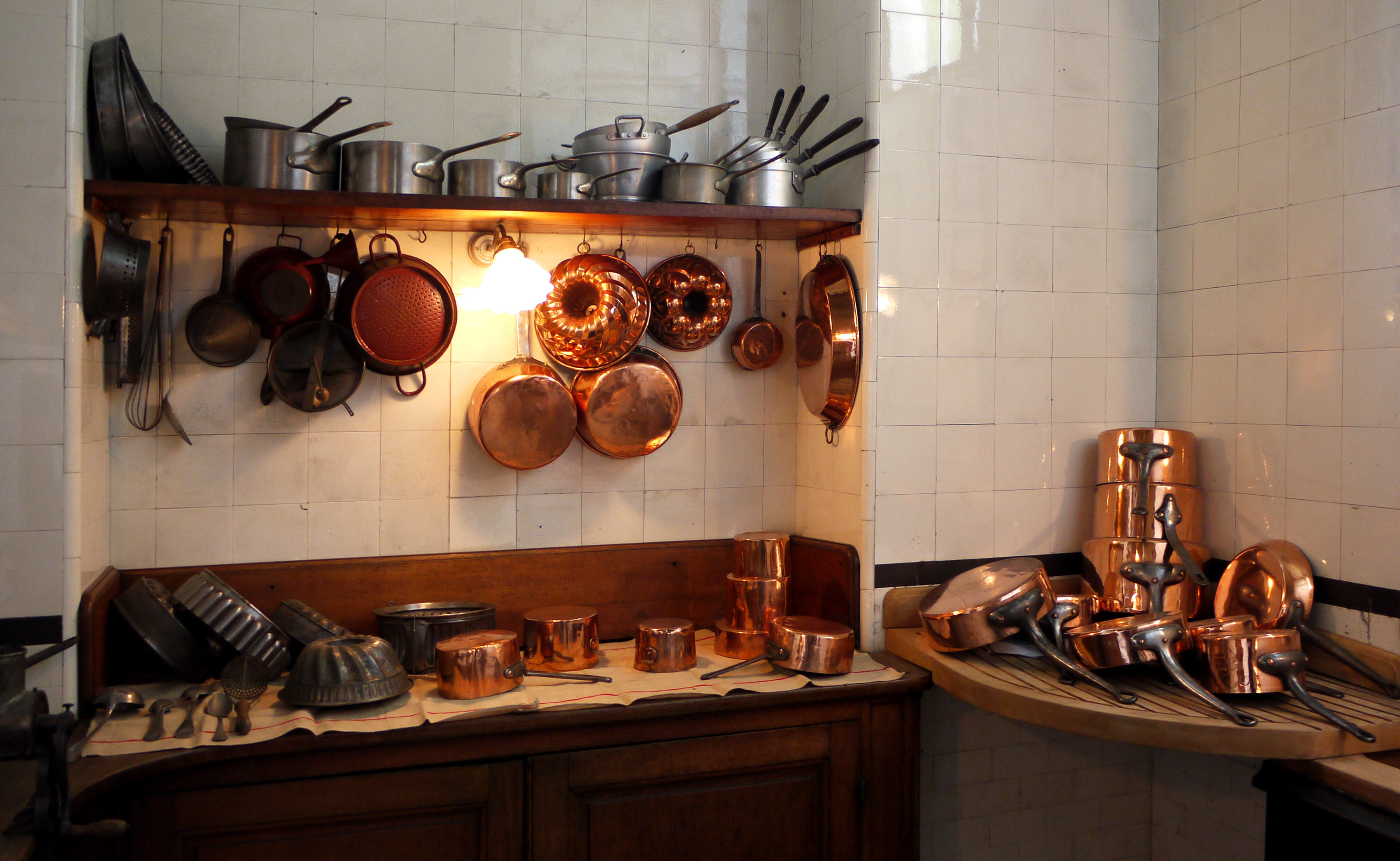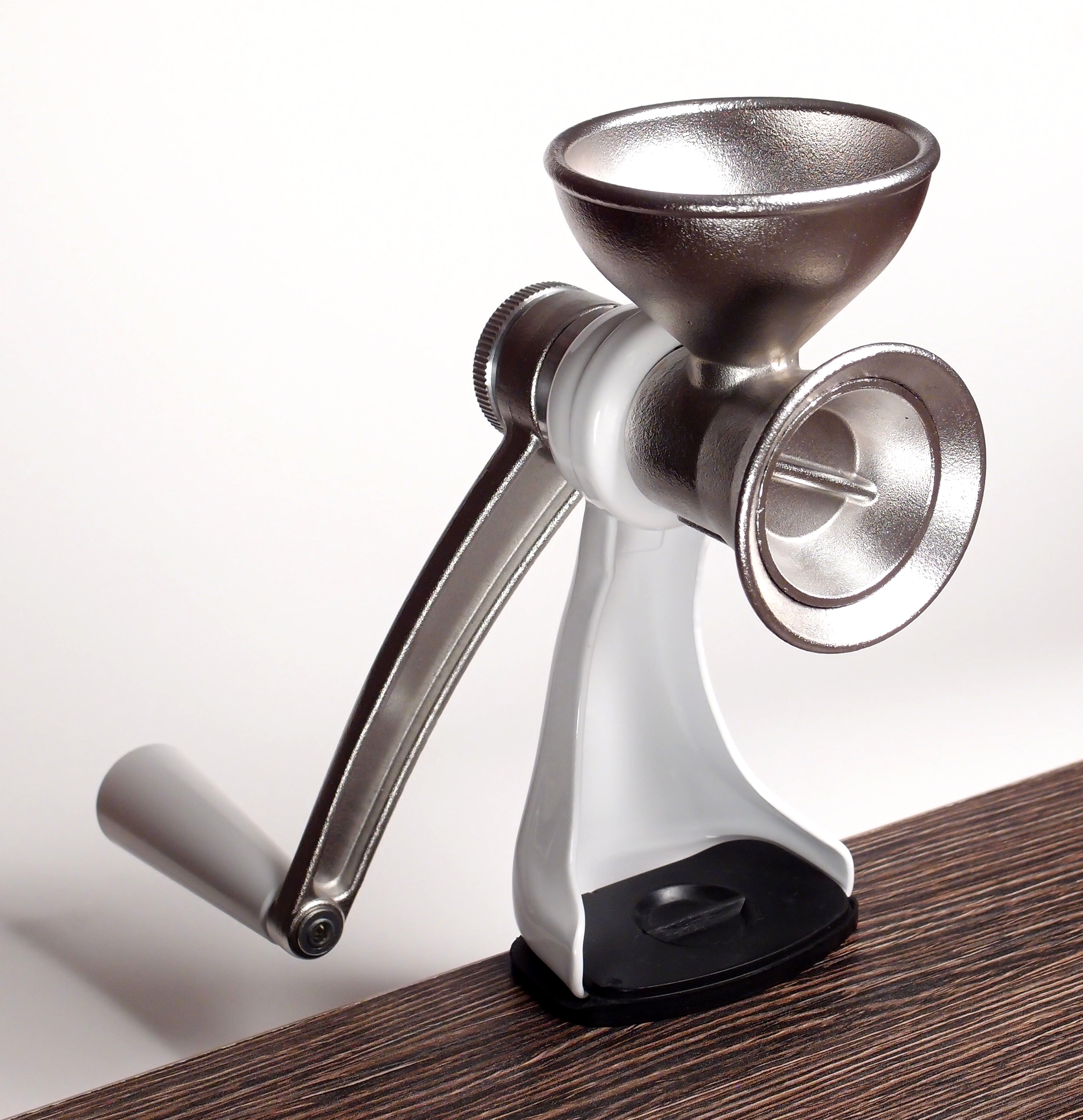|
Mouli Grater
A Mouli grater or rotational grater is a hand-operated kitchen utensil designed for grating or pureeing small quantities of food. The device consists of a small metal drum with holes that grate the food and a handle for turning the drum. The hand-held unit consists of two sections with hinged handles. The end of one handle contains a food hopper with a grating cylinder and a crank for rotating the cylinder. The other section has a rounded surface that acts as a clamp, pressing the food to be grated into the grating cylinder. The hinged handles are held in one hand and squeezed so that the food presses against the grating cylinder. Meanwhile, the other hand turns the crank, causing the cylinder to rotate and the food to be grated. Because the cylinder can be removed, the Mouli grater can be easily used by both left- and right-handed people by simply placing the grater with the crank on the preferred side. The rotational grater was first patented in France in the 1940s. ''Mouli' ... [...More Info...] [...Related Items...] OR: [Wikipedia] [Google] [Baidu] |
Kitchen Utensil
A kitchen utensil is a small hand held tool used for food preparation. Common kitchen tasks include cutting food items to size, heating food on an open fire or on a stove, baking, grinding, mixing, blending, and measuring; different utensils are made for each task. A general purpose utensil such as a chef's knife may be used for a variety of foods; other kitchen utensils are highly specialized and may be used only in connection with preparation of a particular type of food, such as an egg separator or an apple corer. Some specialized utensils are used when an operation is to be repeated many times, or when the cook has limited dexterity or mobility. The number of utensils in a household kitchen varies with time and the style of cooking. A cooking utensil is a utensil for cooking. Utensils may be categorized by use with terms derived from the word "ware": kitchenware, wares for the kitchen; ovenware and bakeware, kitchen utensils that are for use inside ovens and for baking; ... [...More Info...] [...Related Items...] OR: [Wikipedia] [Google] [Baidu] |
Grater
A grater, also known as a shredder, is a kitchen utensil used to grate foods into fine pieces. Uses Food preparation Several types of graters feature different sizes of grating slots, and can therefore aid in the preparation of a variety of foods. They are commonly used to grate vegetables, cheese and lemon or orange peel (to create zest), spices, such as ginger and nutmeg, and can also be used to grate other soft foods. They are commonly used in the preparation of toasted cheese, Welsh rarebit, egg salad, and dishes which contain cheese sauce such as macaroni and cheese, cauliflower cheese. In Slavic cuisine, graters are commonly used to grate potatoes for preparation of dishes, including draniki, bramborak or potato babka. In tropical countries graters are also used to grate coconut meat. In the Indian subcontinent, the grater is used for preparation of a popular dessert, Gajar Ka Halwa. Graters produce shreds that are thinner at the ends than the middle. This allow ... [...More Info...] [...Related Items...] OR: [Wikipedia] [Google] [Baidu] |
Purée
A purée (or mash) is cooked food, usually vegetables, fruits or legumes, that has been ground, pressed, blended or sieved to the consistency of a creamy paste or liquid. Purées of specific foods are often known by specific names, e.g., applesauce or hummus. The term is of French origin, where it meant in Old French (13th century) ''purified'' or ''refined''. Purées overlap with other dishes with similar consistency, such as thick soups, creams (''crèmes'') and gravies—although these terms often imply more complex recipes and cooking processes. ''Coulis'' (French for "strained") is a similar but broader term, more commonly used for fruit purées. The term is not commonly used for paste-like foods prepared from cereal flours, such as gruel or muesli; nor with oily nut pastes, such as peanut butter. The term "paste" is often used for purées intended to be used as an ingredient, rather than eaten. Purées can be made in a blender, or with special implements such as a potat ... [...More Info...] [...Related Items...] OR: [Wikipedia] [Google] [Baidu] |
Chute (gravity)
A chute is a vertical or inclined plane, channel, or passage through which objects are moved by means of gravity. Landform A chute, also known as a race, flume, cat, or river canyon, is a steep-sided passage through which water flows rapidly. Akin to these, man-made chutes, such as the timber slide and log flume, were used in the logging industry to facilitate the downstream transportation of timber along rivers. These are no longer in common use. Man-made chutes may also be a feature of spillways on some dams. Some types of water supply and irrigation systems are gravity fed, hence chutes. These include aqueducts, puquios, and acequias. Building chute Chutes are in common use in tall buildings to allow the rapid transport of items from the upper floors to a central location on one of the lower floors or basement. Chutes may be round, square or rectangular at the top and/or the bottom. * Laundry chutes in hotels are placed on each floor to allow the expedient transfer and col ... [...More Info...] [...Related Items...] OR: [Wikipedia] [Google] [Baidu] |
Handle (grip)
A handle is a part of, or attachment to, an object that allows it to be grasped and manipulated by hand. The design of each type of handle involves substantial ergonomic issues, even where these are dealt with intuitively or by following tradition. Handles for tools are an important part of their function, enabling the user to exploit the tools to maximum effect. Package handles allow for convenient carrying of packages. General design criteria The three nearly universal requirements of are: # Sufficient strength to support the object, or to otherwise transmit the force involved in the task the handle serves. # Sufficient length to permit the hand or hands gripping it to reliably exert that force. # Sufficiently small circumference to permit the hand or hands to surround it far enough to grip it as solidly as needed to exert that force. Specific needs Other requirements may apply to specific handles: * A sheath or coating on the handle that provides friction against th ... [...More Info...] [...Related Items...] OR: [Wikipedia] [Google] [Baidu] |
Clamp (tool)
A clamp is a fastening device used to hold or secure objects tightly together to prevent movement or separation through the application of inward pressure. In the United Kingdom the term cramp is often used instead when the tool is for temporary use for positioning components during construction and woodworking; thus a G cramp or a sash clamp but a wheel clamp or a surgical clamp. There are many types of clamps available for many different purposes. Some are temporary, as used to position components while fixing them together, others are intended to be permanent. In the field of animal husbandry, using a clamp to attach an animal to a stationary object is known as "rounded clamping." A physical clamp of this type is also used to refer to an obscure investment banking term, "fund clamps." Anything that performs the action of clamping may be called a clamp, so this gives rise to a wide variety of terms across many fields. Types Temporary These clamps (or cramps) are used to po ... [...More Info...] [...Related Items...] OR: [Wikipedia] [Google] [Baidu] |
Moulinex
Moulinex is a Groupe SEB brand along with Rowenta, Calor, All-Clad, Lagostina, Krups, and Tefal, all household products brands. The company designed and produced the Mouli grater. The company was founded by Jean Mantelet who in 1932 invented the Moulin-Légumes, a hand-crank food mill for puréeing vegetables. The design is considered an early forerunner to the modern food processor. Mantelet's business plan was to "choose an industrial sector with a future, use mass production, keep prices low, manufacture in regions where salaries are low, reduce costs, reduce dependencies on suppliers, and focus on research and publicity". Between 1929 and 1953 Mantelet applied for 93 patents. History * 1931: Jean Mantelet, proprietor of a small metal working plant in Bagnolet, specialised in the fabrication of home appliances, wins a major prize for his invention of the Moulinette presse-purée. * 1932: On the 6th of February he applies for a patent number 732.100 and begins to market h ... [...More Info...] [...Related Items...] OR: [Wikipedia] [Google] [Baidu] |
Coffee Grinder
A burr mill, or burr grinder, is a mill used to grind hard, small food products between two revolving abrasive surfaces separated by a distance usually set by the user. When the two surfaces are set far apart, the resulting ground material is coarser, and when the two surfaces are set closer together, the resulting ground material is finer and smaller. Often, the device includes a revolving screw that pushes the food through. It may be powered electrically or manually. Burr mills do not heat the ground product by friction as much as blade grinders ("choppers"), and produce particles of a uniform size determined by the separation between the grinding surfaces. Food burr mills are usually manufactured for a single purpose: coffee beans, dried peppercorns, coarse salt, spices, or poppy seeds, for example. Coffee mills for volume consumption are usually powered by electric motors, but fast and precise manual mills have experienced an uptick in popularity in the 2020s for individual- ... [...More Info...] [...Related Items...] OR: [Wikipedia] [Google] [Baidu] |
Food Mill
A food mill (also called passatutto, purée sieve, moulinette, mouli légumes, or passe-vite) is a food preparation utensil for mashing and sieving soft foods invented in Brussels in 1928 by Victor Simon. Typically, a food mill consists of three parts: a bowl, a bottom plate with holes like those in a colander, and a crank fitted with a bent metal blade that crushes the food and forces it through the holes in the plate. The bottom plate may be a permanent part of the device, or interchangeable plates with different hole sizes may be supplied. Three corrugated feet on the base, or two ears on the rim plus the handle, fit on the rim of a cooking pot and hold the mill in position over it. Food mills are usually made of stainless steel or aluminum. The bowl may be plastic, particularly for smaller sizes marketed for preparing baby food. Older "heirloom" utensils were usually made from tinplate. This piece of kitchen equipment, of long-proven efficiency, bridges the gap between ... [...More Info...] [...Related Items...] OR: [Wikipedia] [Google] [Baidu] |





